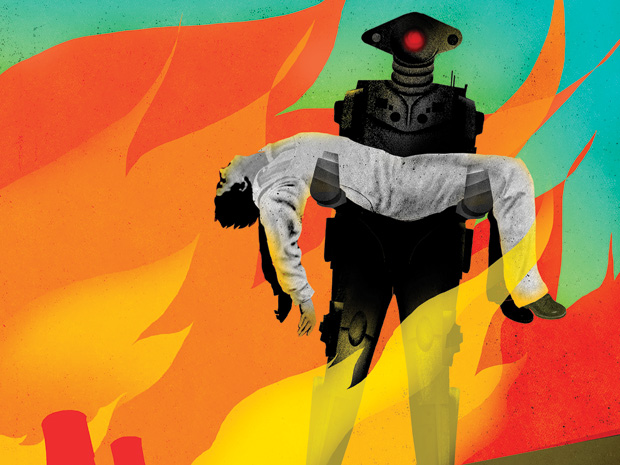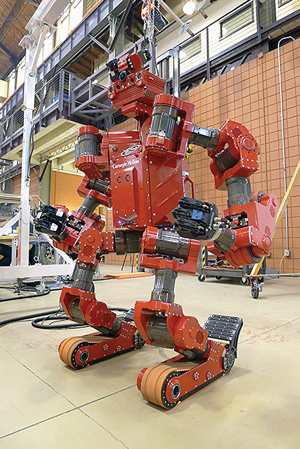 "Where are the robots?" That was what many people were asking when events at Japan's Fukushima nuclear power plant spiraled out of control in March 2011. With deadly levels of radiation collecting inside the damaged reactors, attempting to repair them became too dangerous for an emergency crew. Could Japan, a country known for its automated factories and advanced humanoids, use robots to take the place of human workers and stop the disaster in its tracks?
"Where are the robots?" That was what many people were asking when events at Japan's Fukushima nuclear power plant spiraled out of control in March 2011. With deadly levels of radiation collecting inside the damaged reactors, attempting to repair them became too dangerous for an emergency crew. Could Japan, a country known for its automated factories and advanced humanoids, use robots to take the place of human workers and stop the disaster in its tracks?
The answer, alas, was no: Robots are generally still too limited in what they can do. They may be great for carrying out repetitive tasks in clutter-free environments, but entering a rubble-strewn building, climbing ladders, using fire hoses—these operations are beyond today's best robots.
The U.S. Defense Advanced Research Projects Agency (DARPA) wants to change that. Fukushima was a wake-up call for the robotics community around the world, and DARPA responded by launching its biggest and most ambitious robot R&D program yet. Called the DARPA Robotics Challenge, or DRC, it aims to accelerate the development of robots that can help humans, not only with nuclear emergencies but also with fires, floods, earthquakes, chemical spills, and other kinds of natural and man-made disasters.
 DARPA (some call it the mad science division of the Pentagon) organized the DRC as a kind of Olympic decathlon for robots, open to teams from anywhere on the globe. But instead of running, jumping, and throwing things, the robots will score points by performing various tasks in a simulated industrial disaster. Picture hulking machines driving vehicles, using power tools, and breaking through walls. And instead of a gold medal, the winning team will take home a US $2 million cash prize.
DARPA (some call it the mad science division of the Pentagon) organized the DRC as a kind of Olympic decathlon for robots, open to teams from anywhere on the globe. But instead of running, jumping, and throwing things, the robots will score points by performing various tasks in a simulated industrial disaster. Picture hulking machines driving vehicles, using power tools, and breaking through walls. And instead of a gold medal, the winning team will take home a US $2 million cash prize.
This month, DARPA held a preliminary contest, the DRC Trials; the finals are scheduled for late 2014. These robo-spectacles are certain to draw the attention of the tech world and the general public, raising the stakes for the DRC program. If it's a success, it will spawn a new generation of practical robots—and, perhaps inevitably, endless jokes about a robot uprising.
Robots are not new to disaster response. In the 1980s, Carnegie Mellon University engineers built robots that entered and made repairs inside the damaged reactor at the Three Mile Island nuclear facility, in the United States, and at Chernobyl, in the former Soviet Union. One of the first reported uses of robots in a search-and-rescue operation was in 2001 at the World Trade Center, in New York City, after the 9/11 attacks.
Emergency workers all over the world have since been using small, remotely controlled vehicles equipped with cameras and sensors to locate victims and to map disaster sites. Most of these machines have tracks and look like tiny tanks. Some models have manipulators, but these are not strong or dexterous. In the aftermath of the Fukushima accident, some tracked robots were sent into the reactors, helping to assess the damage and perform cleanup tasks. The machines proved useful, but DARPA believes that disaster robots could do much more.
Organizers of the DRC hope to advance many aspects of robotics, including locomotion, manipulation, perception, and navigation. In the end, DARPA wants robots that can get around as easily as human rescue workers do. Mechanical first responders should also be able to use vehicles and tools designed for people. The DRC requires that the machines be able to exercise a great deal of autonomy, performing tasks with minimum supervision.
That's a ridiculously ambitious goal. To put things into perspective, consider today's most advanced robots. Some, like Honda's Asimo and South Korea's Hubo, can walk and even run. Others, including NASA's Robonaut and Germany's Rollin' Justin, can grasp and use tools. And PR2, developed by the Silicon Valley lab Willow Garage, can map its environment, drive around, and handle objects. A host of tracked vehicles, like iRobot's PackBot, used to disarm bombs, can negotiate rough terrain and perform manipulations. But a robot that can do all that while operating in a deteriorated environment with limited access to communication and power, as DARPA is aiming for, is unheard of. That goal could easily take a decade or two, but the sponsors of the DRC want to show significant progress in just two years.
As Dennis Hong, a roboticist at Virginia Tech, put it, the pace has been "insane." His team is building a humanoid called THOR (Tactical Hazardous Operations Robot), powered by linear actuators that Hong and his colleagues are engineering from scratch.
Although THOR and other DRC contenders have humanoid forms, teams are free to design any kind of machine they want. So it's possible that at the finals we may see robots with distinctly nonhuman shapes or features that enhance their capabilities. The Carnegie Mellon team, for example, is building CHIMP (CMU Highly Intelligent Mobile Platform), which looks like a cross between an ape and a tank. Its limbs have tracks at their extremities, to assist with locomotion over uneven terrain.
DARPA tried to make the program as open as possible, and more than 100 teams registered. In the end, only a dozen or so are expected to make it to the finals. The agency provided some of the teams with financial support. Others are self-funded.
To make the DRC accessible to groups that couldn't afford to build their own robots, DARPA organized a virtual competition, which took place in June. Teams not building hardware had to use a simulator, developed by the Open Source Robotics Foundation, to program a virtual humanoid to perform some of the tasks that will be judged in the real contest.
But here's the best part: The top performers in the virtual competition were each allowed to borrow a $2 million robot from DARPA for the upcoming hardware face-off. The robot, called Atlas, was built by Boston Dynamics, most famous for its BigDog quadruped. Powered by hydraulic actuators, Atlas is nearly 2 meters tall and weighs 150 kilograms—as much as a large refrigerator. In a video demo, a 9-kg wrecking ball hanging by a strap slams into Atlas as it stands on one foot; the robot quickly adjusts its balance.
For teams that receive an Atlas loaner, a big challenge is transferring what they accomplished in simulation to the real robot, where every move must be carefully executed. Make an error in the control algorithm and your Atlas might come crashing down face first. One team reported that a buggy line of code nearly sent one of Atlas's feet into its own chest. Another said that while they were teaching Atlas to walk over concrete blocks, the robot ended up kicking the blocks with enough force to destroy them.
In simulation, you can always try new things and start it all over when it doesn't work, says Michael Gennert, one of the leaders of the Worcester Polytechnic Institute team. With a $2 million robot, not so much. "You can't just reboot it after a crash," he says.
DARPA specifically mentions the Fukushima accident as an example of a disaster that would have benefited from more capable robots. Indeed, the scenario DARPA is planning for the final competition closely resembles the dramatic events that unfolded in the first 24 hours of the Fukushima catastrophe, when workers attempted but ultimately failed to fix one of the crippled reactors.
DRC program manager Gill Pratt rejects the notion that the tasks DARPA has concocted for the robots might be too difficult given the current state of the art. In the agency's parlance, the tasks are "DARPA hard," he says, but not impossible. "It's a goal that has a lot of risk but a lot of reward as well, and that's really the theme of what DARPA tries to do."
Most teams performed reasonably well during the preliminary contest. And they're hopeful that next year their robots will do even better. So you might see a repeat of what happened with the DARPA challenges for self-driving vehicles. As a result of these challenges, robotic cars saw a huge advance. In just a few years, they went from erratic prototypes to reliable machines that were able to drive themselves admirably, first through the desert and later around a mock city. Some of their designers went on to work for Google, developing its now-famous self-driving cars.
The same could happen with the DRC. And even if the challenge fails to foster the creation of practical disaster robots in the near future, it will certainly show their possibilities and propel many technologies forward.
"The actual competition robots are prototypes and not yet ready for deployment," says Seth Teller of the MIT team. "But the DRC is a first and important step toward a future in which, even as disasters like Fukushima unfold, people will be able to send machines to do their bidding."





